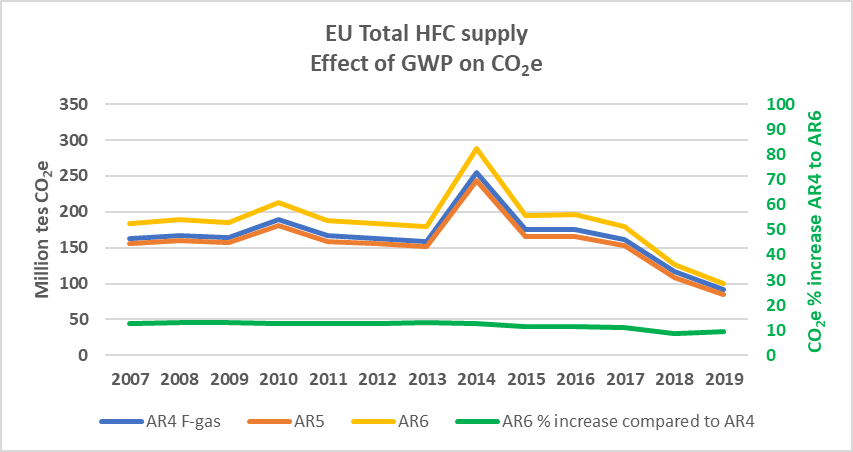IPCC AR6 UPDATED GWP VALUES FOR HFCs and HFOs
IPCC AR6 in - Climate Change 2021, The Physical Science Basis- Chapter 7.SM [1] provides updated GWP values for relevant substances. EFCTC has updated its data tables to include the values from the most recent IPCC Assessment Report and these now include AR6 values. Revised GWPs had been issued between AR5 and AR6 reports, for example in WMO2018 [2] and Hodnebrog 2020 [3], but IPCC has typically been the reference source for this data.
For the AR4, AR5 and AR6 GWPs see Major HFC, HFO and HCFOs; HCFC molecules used as feedstocks. Environmental properties and main applications
For more information about GWPs see the updated LEARN ABOUT…Climate change, global warming & HFCs Selecting and Using GWP values for Refrigerant
For a list of blend refrigerants with AR4, AR5 and AR6 GWPs see the updated Refrigerants Subject to the F-gas Regulation
What has actually changed with the AR6 GWP values: AR6 GWP values are based on the Hodnebrog [3] reported values. The Hodnebrog paper provides an updated and extended assessment of RE (radiative efficiencies) and GWPs for halocarbons. GWPs are defined relative to the absolute value of the GWP for CO2 (AGWPCO2) which mean changes to the parameters in AGWPCO2 impact all GWP values, and the GWP-100 values presented in the paper are about 14% higher than if the old AGWPCO2 from AR5 had been used. The effect of a compound on climate is not limited to its direct radiative forcing. Compounds can perturb the carbon cycle affecting atmospheric CO2 concentrations. AR6 GWP-100 values include the carbon cycle response for non-CO2 compounds to treat CO2 and non-CO2 compounds in a consistent way. Therefore, its inclusion more accurately represents the climate effects of non-CO2 species. This correction was excluded in the Hodnebrog paper [4]. AR6 GWPs for the HFCs are therefore slightly lower than the Hodnebrog values. It is worthwhile noting that the GWPs of two of the major GHGs - methane and nitrous oxide (N2O) - have changed by +33% and –12% respectively between SAR and AR6.
Effect of different GWP sets on the EU total supply as CO2e for the F-gas Regulation

Chart- EU Reported Total Supply of HFCs, Effect of GWP on CO2e
Chart Explanatory notes: EEA report for Fluorinated greenhouse gases 2020 is used for HFC total supply, very minor differences (not visible on this chart) are due to some confidential data in the EEA report for minor individual HFCs.
The effect of different GWP sets (F-gas AR4, AR5, and AR6) on the EU total supply as CO2e is shown in the chart. Clearly the different GWP sets have a similar effect on all years including the HFC phase-down baseline years. This is also shown for EU HFC total supply by the percentage increase for CO2e using AR6 values compared to F-gas AR4 GWP values. The percentage increases for 2007 to 2017 are within the range of 11 to 13%. The increase is 9% in 2018 and 2019 mainly due to a relatively much larger reduction in HFC-143a supply.
The GWP threshold values contained in the F-gas Regulation are set to encourage the use of lower GWP refrigerants to help deliver the phase-down. These are not arbitrary but selected based on available refrigerants and achievable targets. When these were set the uncertainty in refrigerant GWP values was already known (in the range of 30-50%) and any GWP changes do not invalidate the existing policy framework.
F-gas Regulation and Kigali Amendment HFC Phase-downs
The UNFCCC adopted AR5 values for reporting emissions under the Paris Agreement and the Montreal Protocol adopted AR4 values for HFC consumption and production under the Kigali Amendment. Both the Kigali Amendment and the F-gas Regulation set baselines and then require consumption reductions against these baselines. Changing the GWPs for the F-gas Regulation would also change the baselines, as CO2e, resulting in very limited, if any overall effect, except to cause a discrepancy and confusion between measures/reporting under the Montreal Protocol and EU Regulation. The most important feature is to set a consistent HFC phase-down. The ozone depleting potentials (ODPs) used in the Montreal Protocol have not been changed since it was agreed in 1987 to provide regulatory certainty.
References
[1] AR6 IPCC Working Group I- Climate Change 2021, The Physical Science Basis- 7.SM Chapter 7: The Earth’s 2 energy budget, climate feedbacks and climate sensitivity - Supplementary Material
[2]The SAP2018 can be accessed here 2018 Scientific Assessment of Ozone Depletion
[3] Hodnebrog, Ø., Myhre, G., Kramer, R. J., Shine, K. P., Andrews, T., Faluvegi, G., Kasoar, M., Kirkevåg, A., Lamarque, J.-F., Mülmenstädt, J., Olivié, D., Samset, B. H., Shindell, D., Smith, C. J., Takemura, T., Voulgarakis, A.: The effect of rapid adjustments to halocarbons and N2O on radiative forcing, npj Climate and Atmospheric Science, Issue 3, 2020, Pages 1 ff., DOI: https://doi.org/10.1029/2019RG000691
[4] See IPCC AR6 Physical Science Basis 7.6.1.3 Carbon cycle responses and other indirect contributions.